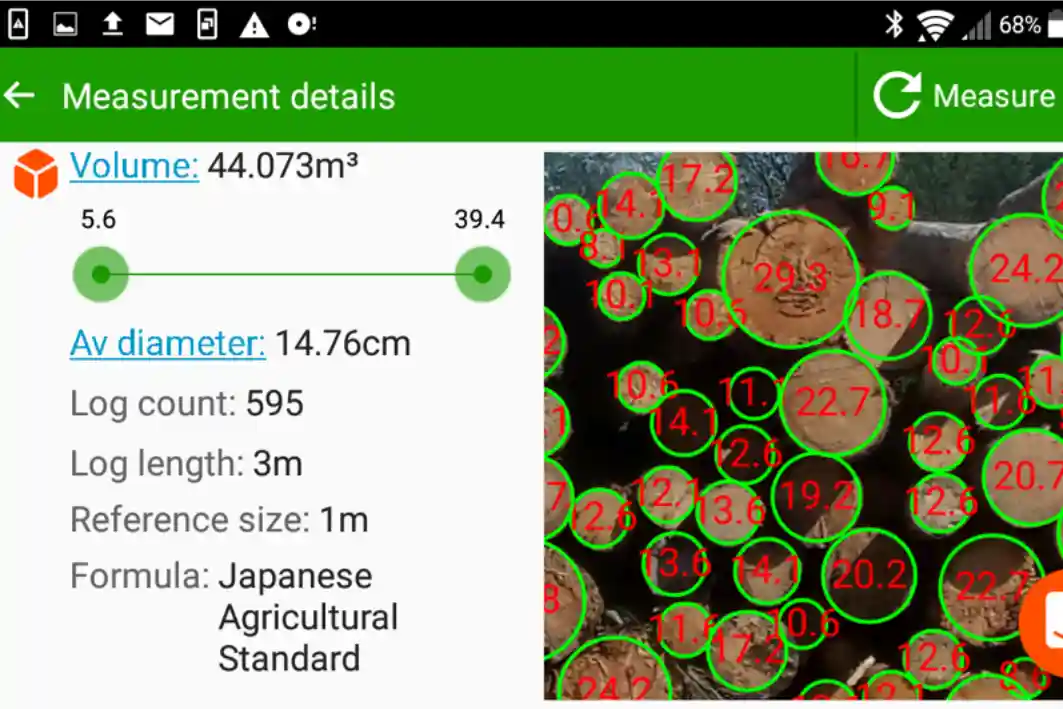We have written about different measurement formulas earlier in our blog. This time, we concentrate on two very important ones: JAS and GOST – that are used most widely in international trade. With Timbeter, it is easy to check the volumes with both formulae. We ran a small experiment and demonstrate how the volumes differ.
JAS was developed in Japan for Roundwood measurement and is based on a formula itself. GOST 2708-75 (stands for “State Standard – Round Timber, Table of Volumes”) was created in the Soviet Union and uses fixed values for certain diameters that come from tables. It’s also interesting to point out that there’s a “GOST” table for as many different standards as you can imagine, from canned meat to requirements for drawings.
Both formulas use the narrow end of the diameter for volume calculation.
JAS scale exact formula is the following:
For logs less than 6m long:
V(m3) = (D²*L)/10000
where:
D – small-end diameter(cm), for less than 14cm the diameter, is rounded down and after 14cm the diameter is rounded down to the nearest even integer.
L – Length(m)
For logs equal to or greater than 6m:
V(m3) = (D + [L’-4]/2)^2*(L/10000)
D – small-end diameter(cm), for less than 14cm the diameter, is rounded down and after 14cm the diameter is rounded down to the nearest even integer.
L – Length(m)
L’ – length in meters rounded down to nearest whole number
For logs, less than 14 cm (nominally) on the small-end measurement needs to be taken through the narrow axis.
For logs with 14 cm and larger, two measurements need to be taken, through the narrow axis and the wide axis of the log end.
For GOST 2708 75, you can find the complete table here.
The difference in rounding diameters
In the case of JAS, the following rules for rounding needs to be followed: for less than 14cm the diameter is rounded down and for logs with more than 14cm, the diameter is rounded down to the nearest even integer.
For GOST, diameters are rounded to the nearest centimeter (12,51 rounds to 13 cm and 12,49 rounds to 12 cm). Diameters over 14 cm are rounded to the nearest even number (24,9 is rounded to 24 cm; 25,1 is rounded to 26 cm).
Timbeter displays on the screen the exact diameter with one decimal place (25,9 cm), but on the tally sheet, the number is already rounded down according to the requirements (24 cm in case of JAS ). So whenever there be a question what is the exact diameter of the log, it is easy to check. The average diameter is also calculated based on the rounded diameters.

Volumes
If we measure a pile of logs with JAS, the volume result is 44,07 m³ and the average diameter is 14,76 cm. If we use GOST, then the result is shown by 43,67. With GOST the average diameter is 15,51 cm.


So, the results are not very different from each other but might still be affected when it comes to large volumes. This difference comes from the fact that the logs are measured differently, according to their own formulas (or tables, in GOST case). So, the numbers have a very small differences, but the user can still face them as coming directly from the way the logs are measured.
Interested in testing different formulas yourself? Download Timbeter from here.
